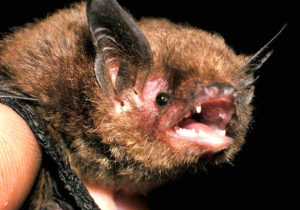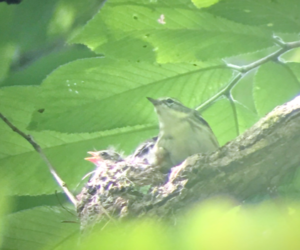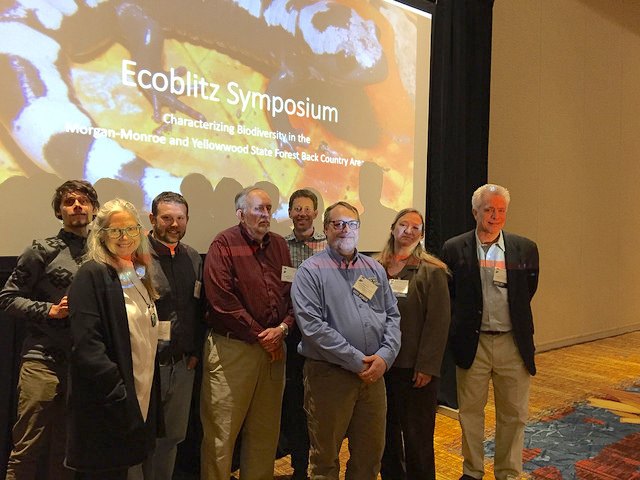What do we know about the wildlife and quality of the ecosystem in a 900-acre, unmanaged Indiana forest? And why do we need to know? Because knowing what life exists in an older forest is important as we determine whether or not it ought to be logged.
IFA’s Ecoblitz is a comprehensive baseline inventory of forest life in a section of Yellowwood and Morgan-Monroe State Forests in Monroe and Brown counties, said Jeff Stant, IFA executive director. The Ecoblitz provides a more complete picture of the biological diversity in older, all-aged, hardwood forests. No such inventory has ever been done before on the state or national forest lands in Indiana.
IFA staff and consulting scientists presented the preliminary results of the four-year Ecoblitz last month at the Indiana Academy of Science. Key results:
How are bats and other mammals faring in this older forest?
 Jeremy Sheets, senior wildlife biologist at Orbis Environmental, reported on mammals in the forest: 28 species were found (there are total of 59 mammal species native to Indiana). “We observed mink, coyote, red fox and bobcat, as well as white-tailed deer, flying squirrels and shrews,” he said. Two species, the pygmy shrew and smoky shrew, are “species of special concern” in Indiana. The bat team documented seven species of bats, and in 2016 and 2017, Indiana bat maternity roosts were found. “Mature forests may not have many game species, but some species are found only in mature forests,” said Sheets.
Jeremy Sheets, senior wildlife biologist at Orbis Environmental, reported on mammals in the forest: 28 species were found (there are total of 59 mammal species native to Indiana). “We observed mink, coyote, red fox and bobcat, as well as white-tailed deer, flying squirrels and shrews,” he said. Two species, the pygmy shrew and smoky shrew, are “species of special concern” in Indiana. The bat team documented seven species of bats, and in 2016 and 2017, Indiana bat maternity roosts were found. “Mature forests may not have many game species, but some species are found only in mature forests,” said Sheets.
How many, and what types, of bees and moths inhabit the forest?
 Lepidopterist Leroy Koehn, who’s collected moths at sites across the nation, remarked on the significant species richness in the forest. He collected moth species in the Ecoblitz forest between April 2017 and January 2018, documenting 1,300 different moth species, some never before seen.
Lepidopterist Leroy Koehn, who’s collected moths at sites across the nation, remarked on the significant species richness in the forest. He collected moth species in the Ecoblitz forest between April 2017 and January 2018, documenting 1,300 different moth species, some never before seen.
Bee expert Rob Jean found 183 bee specimens representing 48 bee species, and all 5 major bee families in Indiana. “Bees are important forest pollinators and forests offer good nesting habitat,” said Jean. This summer’s Ecoblitz efforts may determine if the federally endangered rusty patched bumble bee might still exist in these forests where it was once reported prior to major decline.
What are the characteristics of this forest?
Leslie Bishop, Ph.D., Professor Emerita of Biology from Earlham College, and science advisor for Indiana Forest Alliance, presented the preliminary results of a forest characterization study. “The Ecoblitz area of Morgan-Monroe/Yellowwood State Forests has characteristics of a mature forest (such as composition, snags, and woody debris) comparable to several Indiana nature preserves. It’s a textbook example of a mature forest, indicating progression toward secondary old growth,” Dr. Bishop reported. From tree core data, the average tree age is 114 years old, with the oldest tree (an American Beech) being 233 years old. In addition, an analysis of the herbaceous community shows that this forest retains the historic diversity of vascular plants characteristic of a mature deciduous forest of Indiana’s Highland Rim Natural Region.
Are cerulean warblers (a migratory bird) successfully reproducing in this forest?
 Yes. David Rupp of Indigo Birding Tours and the bird team sought this particular bird, which is on the state of Indiana’s endangered species list. “This species starts in Brazil and migrates up through Indiana,” said Rupp. “It prefers large, mature forest with high canopies.” Listening for their mating songs and spotting their nests in the forked limbs of tree tops, Rupp and team found 10 male territories in creek beds and floodplains, including two nests where baby birds successfully fledged. In the study overall, 68 bird species were identified.
Yes. David Rupp of Indigo Birding Tours and the bird team sought this particular bird, which is on the state of Indiana’s endangered species list. “This species starts in Brazil and migrates up through Indiana,” said Rupp. “It prefers large, mature forest with high canopies.” Listening for their mating songs and spotting their nests in the forked limbs of tree tops, Rupp and team found 10 male territories in creek beds and floodplains, including two nests where baby birds successfully fledged. In the study overall, 68 bird species were identified.
How many lichens were found, and why are they important?
James Lendemer, Ph.D., serves on staff at the New York Botanical Gardens. IFA invited him to Indiana to conduct a lichen study last spring. Lichens are a symbiotic combination of algae and fungus that require very specialized conditions. In the Ecoblitz area, Lendemer collected 406 lichens and found 108 different species. “More than half were found fewer than three times, indicating great diversity,” he said. Lendemer’s work is a contribution to Indiana science because 59% of the species he cataloged had not been on record as existing in the state.
What can we conclude?
After four years, the Ecoblitz has catalogued 3,316 species (with more to come as a large batch of insects is catalogued and identified by faculty and students at Hanover College). This relatively undisturbed forest in the Back Country Area (BCA) of Morgan-Monroe State Forest has great species complexity and high species richness in the absence of intense forest management. One tract of Yellowwood has been logged, but other parts of the BCA remain intact for now, and IFA will continue the Ecoblitz in these unlogged areas.
We conclude: “This forest would be an invaluable resource as a set-aside reserve for understanding natural aging processes of forests,” said Dr. Leslie Bishop.
The Indiana Forest Alliance is grateful to the Indiana Academy of Science for providing a venue to present these findings, and to these funders for their multi-year support of the Ecoblitz: Nina Mason Pulliam Charitable Trust, Efroymson Family Fund, the Amos Butler Audubon Society, and the Indiana Academy of Science.

